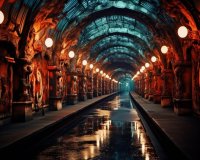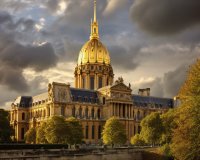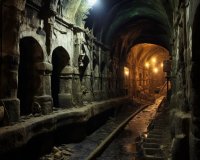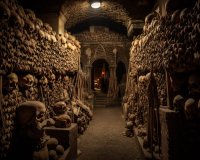The Influence of Military Conflicts on Parisian Culture and Art
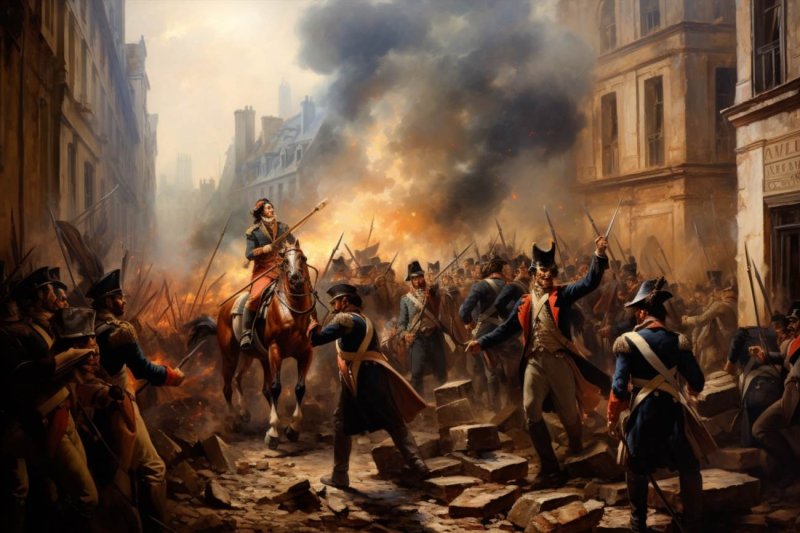
The Influence of Military Conflicts on Paris's Culture and Art
Paris, often referred to as the "City of Light," has a rich cultural and artistic history that has been shaped by various factors throughout the centuries. One significant influence on Paris's culture and art is the impact of military conflicts that the city has witnessed.
World War I:
The First World War, which ravaged Europe from 1914 to 1918, left an indelible mark on Paris. The city became a hub for artists, writers, and intellectuals who sought refuge from the war-torn regions. This influx of creative minds contributed to the flourishing of artistic movements such as Dadaism and Surrealism. The trauma of war also found expression in various art forms, reflecting the collective anguish and questioning of societal norms.
Occupation during World War II:
During World War II, Paris endured a dark period of German occupation from 1940 to 1944. This tumultuous time had a profound impact on the city's cultural landscape. The Nazi regime sought to control artistic expression, leading to censorship and persecution of artists who resisted. However, the Parisian underground resistance, including many artists, fought to preserve the city's cultural identity. The liberation of Paris in 1944 marked a triumphant moment for the arts, symbolizing the resilience of creativity in the face of oppression.
The Algerian War:
The Algerian War of Independence (1954–1962) stirred political and social unrest in France, with Paris as a focal point for protests and debates. Artists and intellectuals engaged in discussions about colonialism, identity, and human rights. This period witnessed the emergence of socially engaged art that tackled pressing issues of the time. The struggle for independence in Algeria had a lasting impact on the collective consciousness of Parisians and influenced artistic expressions that questioned the status quo.
Post-Cold War Era:
The end of the Cold War brought about geopolitical shifts that influenced global dynamics. Paris, as a cosmopolitan city, absorbed these changes and reflected them in its art scene. The city became a melting pot of diverse influences, fostering a multicultural and inclusive artistic environment. The proliferation of technology also opened new avenues for artistic expression, leading to the integration of digital media into traditional art forms.
Conclusion:
In conclusion, the influence of military conflicts on Paris's culture and art is a complex and multifaceted phenomenon. From the trauma of war to the resilience of the human spirit, these historical events have shaped the artistic landscape of Paris in profound ways. The city's ability to adapt and evolve in the face of adversity is a testament to the enduring power of art and culture.
Paris Catacombs Small-Group Tour: Unveiling the Dark Secrets Below
Discover the enigmatic depths of Paris with our Small-Group Catacombs Tour featuring skip-the-line entry. Presented by LivItaly Tours LLC, this immersive experience offers a unique perspective on the catacombs' history and mysteries.
Overview
Beneath the vibrant city lights of modern Paris lies a shadowy realm—the catacombs. This small-group tour provides exclusive access to restricted areas, allowing you to explore the 200-mile maze of remains from around 6 million Parisians. Led by an expert guide, this journey unveils the chilling history and captivating stories hidden beneath the surface.
Details
Your adventure commences with a bone-chilling descent down the complex’s 133-step staircase, revealing the 13th-century use of these tunnels for limestone quarrying. As you navigate the narrow passages, discover why Parisians turned to the catacombs for burials during the tumultuous 1780s. Marvel at the disturbingly detailed bone decorations, from religious iconography to "The Barrel," a construction of various skeletal remains in the Crypt of the Passion.
Gain insights into the catacombs' role in historic events, from serving as wartime bunkers in World War II to its connection with the French Revolution. Your guide will share tales of the catacombs' unconventional use, including hosting raves and swimming parties by the cataphiles, daring adventurers in this underground city of the dead.
Highlights
- Small-group tour for an intimate experience
- Skip-the-line access to the Paris Catacombs
- Exclusive exploration of restricted areas
- Expert guide providing in-depth historical insights
Meeting Point
Meet your guide in front of the Catacomb's main entrance at 1 Avenue du Colonel Henri Rol-Tanguy, Paris, France. Look for the LivTours sign for a seamless start to your journey into the depths.
Customer Reviews
Rated at an impressive 4.9/5 based on 54 reviews, our tour has received acclaim for its knowledgeable guides, value for money, and the unique experience it offers. Travelers have commended the tour's immersive storytelling and the expertly led exploration of the catacombs' secrets.
Book your spot now to embark on a journey that goes beyond the surface, revealing the hidden stories and bone-chilling wonders of the Paris Catacombs.
Art Evolution During Conflicts: The Story of Paris
Throughout history, art has often evolved in response to the turbulent backdrop of conflicts and wars. The city of Paris, with its rich artistic heritage, provides a fascinating case study of how art has both reflected and shaped the narrative during times of strife. This article delves into the art evolution during conflicts in Paris, showcasing the resilience and creativity of artists amid chaos.
Paris, known as the "City of Light" and celebrated for its cultural contributions, has faced numerous conflicts that left an indelible mark on its artistic landscape. From the French Revolution to World War II, each period of turmoil brought forth unique artistic expressions and responses.
The French Revolution: Art in the Age of Uprising
At the end of the 18th century, the French Revolution brought radical change to Paris. The art of this era was marked by themes of liberty, equality, and fraternity. Painters like Jacques-Louis David produced stirring works that celebrated revolutionary ideals. The iconic painting "The Death of Marat" stands as a testament to the dramatic shift in artistic expression, portraying a martyred revolutionary figure.
The revolutionary spirit also inspired new forms of public art. Streets and squares were adorned with statues and monuments, reinforcing the idea of a nation in transformation. These artworks became powerful symbols of the revolutionary zeal and a source of inspiration for generations to come.
World War I: Art Amidst Devastation
As the world plunged into the horrors of World War I, Paris found itself at the center of the conflict. The art of this era took on a different tone, reflecting the trauma and devastation of the war. Cubism, an avant-garde movement, gained prominence. Artists like Pablo Picasso explored fragmented forms and distorted perspectives, mirroring the fractured world they witnessed.
Simultaneously, the city became a refuge for artists fleeing the war in other parts of Europe. Montparnasse and Montmartre attracted writers, painters, and intellectuals, creating a vibrant, international artistic community. This period of convergence gave rise to new artistic movements, such as Dadaism, Surrealism, and the "Lost Generation" of writers, forever altering the artistic landscape of Paris.
World War II: The Resistance and Art
During World War II, Paris endured Nazi occupation, and the art world faced both censorship and resistance. Artists like Marc Chagall and Fernand Léger remained in the city, covertly producing works that conveyed messages of defiance and hope. The "Museum of Modern Art" in Paris became a refuge for confiscated artworks, safeguarding the cultural heritage of France.
One of the most significant events of this period was the recovery of stolen art by the Allies, including the Monuments Men, who worked tirelessly to repatriate looted works. Their efforts contributed to the preservation of Europe's artistic heritage and highlighted the importance of art in times of conflict.
Post-War Renaissance: Rebuilding Through Art
After the tumultuous years of World War II, Paris experienced a renaissance of art and culture. The existentialist movement, led by philosophers like Jean-Paul Sartre and Albert Camus, explored the meaning of existence in a world marked by conflict. Artists like Jean Dubuffet introduced the art brut movement, emphasizing raw, untrained creativity.
The city itself became a canvas for artistic expression. The "Lovers of Teruel" mural by Picasso, located in the Château de Vallauris, serves as a symbol of reconciliation and unity in a post-war world.
Conclusion: Paris, a Beacon of Artistic Resilience
Throughout its history, Paris has been a testament to the enduring power of art in the face of conflict. From the revolutionary fervor of the French Revolution to the wartime resilience of World War II, the city's art has evolved, adapting to the challenges and upheavals of the times. The art of Paris stands as a reminder that even in the darkest moments, creativity can flourish and provide solace, resistance, and inspiration to generations to come.
In times of conflict, Parisian artists have proven that the canvas can be a battleground for ideas, a sanctuary for expression, and a mirror reflecting the soul of a city and its people.
Les Invalides: Explore Napoleon's Legacy at the Army Museum
Discover the rich history of France through a fascinating journey into one of the world's premier military history and art collections. This entry ticket allows you to delve into the heart of Les Invalides, where you'll find the illustrious tomb of Napoleon I beneath the majestic golden Dôme des Invalides.
About this Ticket:
- Free cancellation: Cancel up to 24 hours in advance for a full refund.
- Reserve now & pay later: Book your spot today and pay nothing until you're ready to explore.
- Covid-19 precautions: Special health and safety measures are in place—check your activity voucher for details.
- Valid for 1 day: Check availability for starting times.
- Wheelchair accessible.
Key Highlights:
- Visit the tomb of Napoleon Bonaparte in the Dome Church.
- Explore the extensive arms and armor collection, one of the largest globally.
- Immerse yourself in over 500,000 pieces spanning from the Middle Ages to the present day.
- Witness a special exhibition dedicated to the French special forces—L'exposition.
Your Experience:
Step into the Hotel National des Invalides, originally created by Louis XIV for veterans and wounded soldiers. Now housing the musee de l'Armee, marvel at the world-renowned gilded Dome, Napoleon's resting place since 1861. Wander through the collections, featuring armor, weapons, swords, cannons, paintings, photographs, and personal belongings of key French figures. Engage in interactive digital experiences to better understand pivotal battles in France's history. Don't miss the temporary exhibit celebrating the 30th anniversary of the Special Ops Command.
Includes:
- Access to permanent collections, Dome Church (Napoleon's tomb), Museum of Plans-Reliefs, Museum of l'Ordre de la Libération.
- Entry covers temporary exhibitions, guided tours, and a multimedia guide.
- Free entry for children (17 and younger) and EU citizens (18-25) with ID.
Meeting Point:
Avoid queues by showing your tickets at the entrance. Given the multiple museums and the Dome, you may need to present your ticket for each part of the site. Keep your ticket until the end of your visit.
Important Information:
- Access the site via the Esplanade des Invalides.
- First and Second World War areas are closed from January 9 to June 30, 2023, due to construction.
- Cloakrooms are closed.
- Free museum admission for those under 18 and EU citizens under 26 (with ID).
- Tills close 30 minutes before the museum closes.
- Closed on January 1, May 1, and December 25.
Customer Reviews:
Rated 4.6/5 based on 3442 reviews, visitors appreciate the value for money, service, and organization. Explore the extensive exhibits and immerse yourself in the history and beauty of Les Invalides.
The Transformation of Parisian Culture
Paris, often referred to as the "City of Light," is not just a place on the map; it's a living, breathing entity with its own unique culture. Over the centuries, Parisian culture has undergone numerous transformations, influenced by historical events, artistic movements, and the ever-evolving social landscape.
A Historical Tapestry
When we think of Parisian culture, it's impossible to divorce it from its rich history. The city itself is a living museum, with every street corner telling a story. From the tumultuous days of the French Revolution to the Belle Époque, each era has left an indelible mark on the culture of Paris.
During the 19th century, Paris experienced a significant transformation with the urban planning efforts of Georges-Eugène Haussmann. The wide boulevards, grand parks, and iconic landmarks such as the Eiffel Tower all contributed to the city's unique aesthetic. This transformation of the city's physical landscape also impacted the way Parisians interacted with their environment and with each other.
Artistic Flourishing
Paris has long been a haven for artists, writers, and thinkers. The 20th century saw the emergence of various artistic movements, from Impressionism to Surrealism. The city's vibrant art scene provided a platform for artists like Picasso, Dali, and Hemingway to thrive. The cafes of Montparnasse and the galleries of Montmartre were epicenters of creative energy, and the exchange of ideas shaped not only Parisian culture but the world of art as a whole.
Cuisine and Gastronomy
No exploration of Parisian culture is complete without delving into its culinary scene. French cuisine is renowned worldwide for its elegance and flavor. The city's cafes, bistros, and Michelin-starred restaurants offer a diverse range of culinary experiences. From escargot to croissants, Parisian food culture has influenced global tastes, and each meal is an opportunity to savor the essence of the city.
The Language of Love
The French language itself is an integral part of Parisian culture. The melodious sound of French spoken on the streets, in theaters, and in the pages of literary works is a testament to the city's linguistic heritage. The French take immense pride in their language, and its preservation is seen as a crucial aspect of maintaining their cultural identity.
Contemporary Paris
Today, Paris continues to transform and adapt to the changing world. The digital age has brought new opportunities and challenges, influencing the way Parisians connect with one another and with the global community. The city remains a hub for innovation, fashion, and design, while also holding onto its traditions and values.
In recent years, environmental concerns have also become an important part of Parisian culture. The city's commitment to sustainability and green initiatives is a testament to its ability to evolve while remaining true to its core identity.
In Conclusion
Parisian culture is a multifaceted tapestry woven with the threads of history, art, cuisine, language, and a willingness to adapt. The city's ability to transform while preserving its rich heritage is what makes it truly unique. As we look to the future, Paris will undoubtedly continue to evolve, and its culture will remain a source of inspiration for people around the world.


